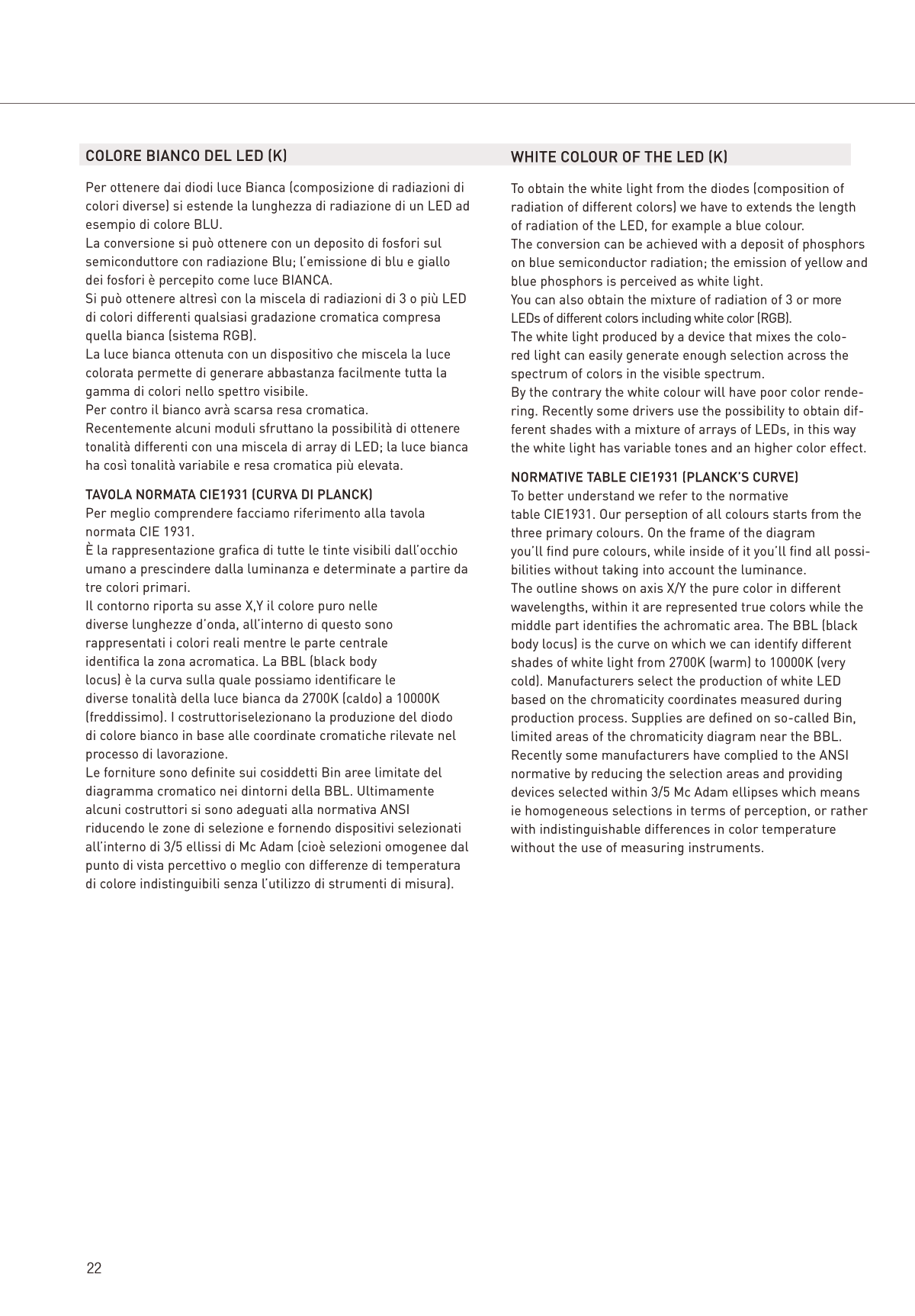COLORE BIANCO DEL LED (K)
Per ottenere dai diodi luce Bianca (composizione di radiazioni di
colori diverse) si estende la lunghezza di radiazione di un LED ad
esempio di colore BLU.
La conversione si può ottenere con un deposito di fosfori sul
semiconduttore con radiazione Blu; l’emissione di blu e giallo
dei fosfori è percepito come luce BIANCA.
Si può ottenere altresì con la miscela di radiazioni di 3 o più LED
di colori differenti qualsiasi gradazione cromatica compresa
quella bianca (sistema RGB).
La luce bianca ottenuta con un dispositivo che miscela la luce
colorata permette di generare abbastanza facilmente tutta la
gamma di colori nello spettro visibile.
Per contro il bianco avrà scarsa resa cromatica.
Recentemente alcuni moduli sfruttano la possibilità di ottenere
tonalità differenti con una miscela di array di LED; la luce bianca
ha così tonalità variabile e resa cromatica più elevata.
TAVOLA NORMATA CIE1931 (CURVA DI PLANCK)
Per meglio comprendere facciamo riferimento alla tavola
normata CIE 1931.
È la rappresentazione grafica di tutte le tinte visibili dall’occhio
umano a prescindere dalla luminanza e determinate a partire da
tre colori primari.
Il contorno riporta su asse X,Y il colore puro nelle
diverse lunghezze d’onda, all’interno di questo sono
rappresentati i colori reali mentre le parte centrale
identifica la zona acromatica. La BBL (black body
locus) è la curva sulla quale possiamo identificare le
diverse tonalità della luce bianca da 2700K (caldo) a 10000K
(freddissimo). I costruttoriselezionano la produzione del diodo
di colore bianco in base alle coordinate cromatiche rilevate nel
processo di lavorazione.
Le forniture sono definite sui cosiddetti Bin aree limitate del
diagramma cromatico nei dintorni della BBL. Ultimamente
alcuni costruttori si sono adeguati alla normativa ANSI
riducendo le zone di selezione e fornendo dispositivi selezionati
all’interno di 3/5 ellissi di Mc Adam (cioè selezioni omogenee dal
punto di vista percettivo o meglio con differenze di temperatura
di colore indistinguibili senza l’utilizzo di strumenti di misura).
WHITE COLOUR OF THE LED (K)
To obtain the white light from the diodes (composition of
radiation of different colors) we have to extends the length
of radiation of the LED, for example a blue colour.
The conversion can be achieved with a deposit of phosphors
on blue semiconductor radiation; the emission of yellow and
blue phosphors is perceived as white light.
You can also obtain the mixture of radiation of 3 or more
LEDs of different colors including white color (RGB).
The white light produced by a device that mixes the colo-
red light can easily generate enough selection across the
spectrum of colors in the visible spectrum.
By the contrary the white colour will have poor color rende-
ring. Recently some drivers use the possibility to obtain dif-
ferent shades with a mixture of arrays of LEDs, in this way
the white light has variable tones and an higher color effect.
NORMATIVE TABLE CIE1931 (PLANCK’S CURVE)
To better understand we refer to the normative
table CIE1931. Our perseption of all colours starts from the
three primary colours. On the frame of the diagram
you’ll find pure colours, while inside of it you’ll find all possi-
bilities without taking into account the luminance.
The outline shows on axis X/Y the pure color in different
wavelengths, within it are represented true colors while the
middle part identifies the achromatic area. The BBL (black
body locus) is the curve on which we can identify different
shades of white light from 2700K (warm) to 10000K (very
cold). Manufacturers select the production of white LED
based on the chromaticity coordinates measured during
production process. Supplies are defined on so-called Bin,
limited areas of the chromaticity diagram near the BBL.
Recently some manufacturers have complied to the ANSI
normative by reducing the selection areas and providing
devices selected within 3/5 Mc Adam ellipses which means
ie homogeneous selections in terms of perception, or rather
with indistinguishable differences in color temperature
without the use of measuring instruments.
XXX-XXX Prima parte.indd 17
19/11/13 09:59
22


